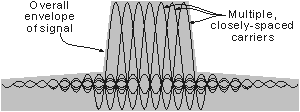DMB Digital Multimedia Broadcasting
- an overview of the DMB system, and in particular the T-DMB version to be
used for mobile video broadcasts.
Digital Multimedia broadcasting, DMB is based on the Eureka
147 Digital Audio Broadcast or DAB system that is widely deployed in the UK and
many other countries around the world for audio broadcasting. One of the
advantages of using DMB is that it can be rolled out and used without much
modification for mobile video applications, simply increasing the level of error
correction to cope with the mobile environment.
In view of the different broadcasting platforms that could be
used account needs to be taken of this. Eureka 147 allows for broadcasts both
from terrestrial transmitters and from satellite based transmitters. For DMB
both platforms are possible, but in view of the differing platforms and
transmission requirements there would need to be some modifications between the
two systems. For terrestrial based transmissions a flavour of the system
designated as T-DMB (Terrestrial Digital Multimedia Broadcasting) is used,
whereas for satellite broadcasting S-DMB (Satellite Digital Multimedia
Broadcasting) is used.
RF signal characteristics
Like many other broadcasting systems, DMB and DAB use a form of transmission
known as Orthogonal Frequency Division Multiplex (OFDM). This has been adopted
because of its high data capacity and suitability for applications such as
broadcasting. It also offers a high resilience to interference, can tolerate
multi-path effects and is able to offer the possibility of a single frequency
network, SFN.

OFDM Spectrum
Note on OFDM:
Orthogonal Frequency Division Multiplex (OFDM) is a
form of transmission that uses a large number of close spaced carriers
that are modulated with low rate data. Normally these signals would be
expected to interfere with each other, but by making the signals
orthogonal to each another there is no mutual interference. This is
achieved by having the carrier spacing equal to the reciprocal of the
symbol period. This means that when the signals are demodulated they
will have a whole number of cycles in the symbol period and their
contribution will sum to zero - in other words there is no interference
contribution. The data to be transmitted is split across all the
carriers and this means that by using error correction techniques, if
some of the carriers are lost due to multi-path effects, then the data
can be reconstructed. Additionally having data carried at a low rate
across all the carriers means that the effects of reflections and
inter-symbol interference can be overcome. It also means that single
frequency networks, where all transmitters can transmit on the same
channel can be implemented.
|
DMB format
The transmissions for the form of DMB being deployed in many countries occupy
approximately 1.5 MHz bandwidth and for the VHF broadcasts the transmission
contains 1536 Carriers. However it is possible to use a variety of modes:
- 2K mode 1536 carriers
- 1K mode 768 carriers
- 0.5K mode 384 carriers
- 0.25K mode 192 carriers
Frequency allocations
It would be possible to utilise the DAB transmission system within the UK for
DMB, however much of the capacity has been taken up, although some reserve
capacity has been retained for future data transmissions of which DMB could be
part.
A more likely solution for DMB is to use frequencies within
the L-Band DAB allocation (1452 - 1467.5 MHz). This might be possible in some
countries where the use of this broadcasting allocation could be used for this
purpose with little legislation.
Using a new band it will not only be possible to use smaller
antennas, an important element for mobile phones and PDAs, but it will also be
possible to tailor the transmission to accommodate the Doppler shifts likely to
be encountered by small mobile devices. This can be achieved by reducing the
number of carriers. Despite the carrier number reduction, the maximum data rate
of 1.152 Mbps is still retained. The drawback of using the L band frequencies is
that they would require a much higher density of transmitters to provide the
required coverage.
Battery consumption
One of the major requirements for any mobile video system such as DMB is that it
shall not place a major load on the battery of the handheld device. With user
expectations requiring that battery life shall be several days between
recharges, this is a major consideration. While battery technology is improving,
and IC technology has enabled current consumption of chips to be reduced, the
basic technology can also play its part.
DMB is also ideally suited to the delivery of material to
handheld devices. DAB inherently includes a technique known as time slicing by
using an effectively using a Time Division Multiplexing delivery method. In this
way the receiver is only switched on when it is required, thereby saving battery
power.
Summary
It remains to be seen whether DMB or DVB-H will be the major standard that is
adopted for mobile video. Some indicate that both schemes may be used in
different countries around the world Accordingly many chip manufacturers whoa re
addressing this market are catering for both schemes and developing systems that
will be able to switch between the variety of bands that will be used around the
globe.
In addition to this DMB trials are well advanced,
particularly in Korea where it appears DMB will be adopted. For other countries,
it remains to be seen what happens.
|

